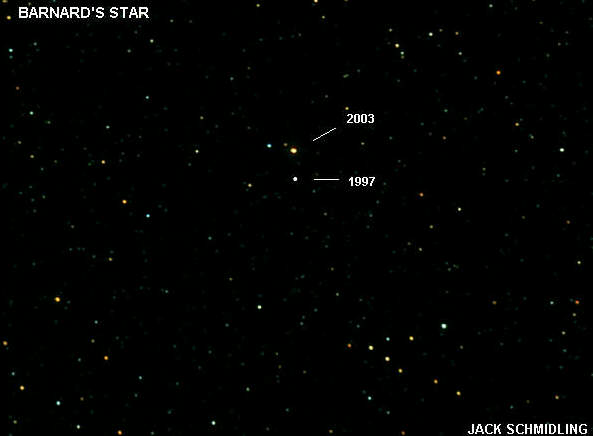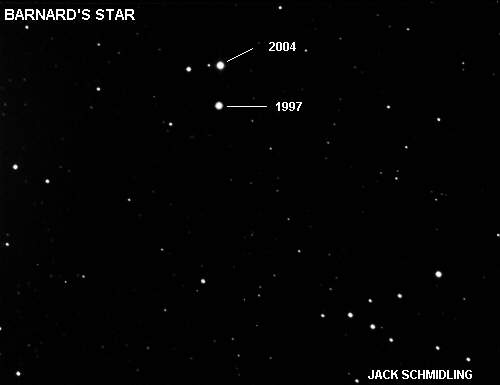![[plato]](barnard.jpg)
![[Copernicus]](barndss.jpg)
| Astrophoto Page | Astrophoto Index | JSP Homepage |
This faint red dwarf is famous for having the greatest proper motion of any star known. This means that it moves rapidly with respect to the background stars. At about 10 arcseconds per year, it moves about one moon width in 180 years. Not much compared to the planets but for a star, it is well deserving of the "Runaway" label.
A large proper motion indicates (among other things) that the object is closer than those with smaller proper motion. Again, the vastly closer planets' proper motion is obvious almost on a daily basis... hence the term planet derives from the word for "wanderers".
At a distance of 6 light years, Barnard's star is our second nearest neighbor star. Only the Alpha Centauri system is closer. It is a red dwarf of apparent magnitude 9.5 and a luminosity of about 1/2500 that of the sun. Although it's mass is only about 16% that of the Sun, being only 140,000 miles in diameter, it is about 40 times denser than the Sun. It is traveling toward the Sun at about 87 miles per second and in 8000 years will be "only" 4 light years away.
A Jupiter sized planet, revolving around Barnard's Star, was announced by P. van de Kamp long before the current glut of "extra-solar planets" but little has been heard of it recently.
For those wishing to see the Runaway star, now is the time to do it. That nice arrow asterism that points to the 1960 location, won't be so handy in a few hundred years.
The photo on the left below was taken by me and the one on the right is a Palomar Sky Survey for comparison. The Palomar photo was "de-enhanced" to remove the clutter of faint stars resulting from the larger/faster system and longer exposure.
![[plato]](barnard.jpg) |
![[Copernicus]](barndss.jpg) |
|
Vintage 1950 Palomar Sky Survey, 48" Schmidt |
It will be interesting to see how many years it will take before I can detect movement on my own negatives.
About a year ago I promised to post another photo of this star in one year to see if we can detect any movement with our humble amateur equipment. The answer turns out to be yes...
A few things have changed since the first photo was taken to further complicate this project. First of all, the initial one was taken with the 10" F6 and this one with the new 16" F4.5. This means that the two different focal lengths produce two different image scales on the negative. One of the images had to be re-scaled and rotated to match the other with a consequent reduction in resolution. Nevertheless, the proper motion over a ten month period is clearly visible.


The movement North over 6 years is about 60 arc seconds.

The motion since last year is easy to see when compared to the small star just to the left of Barnard's Star in both images.